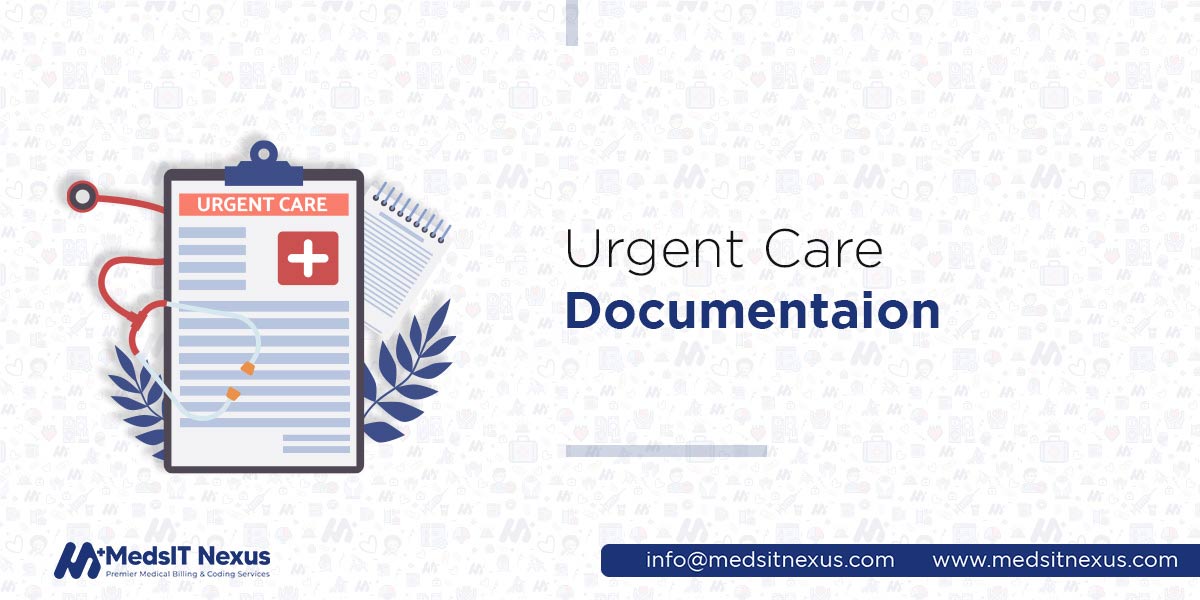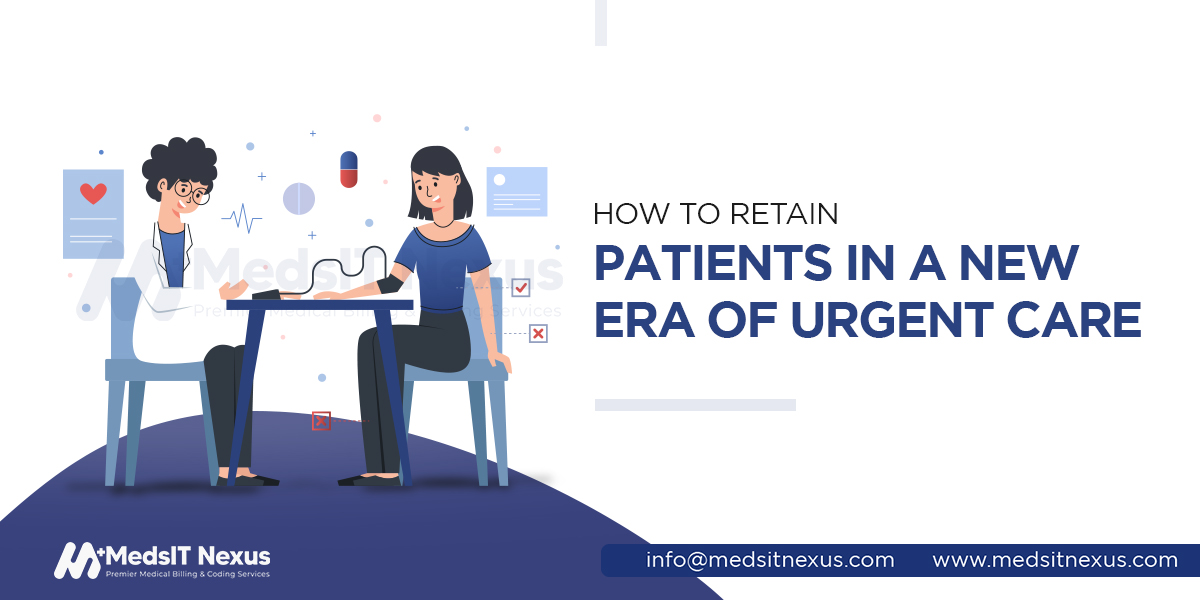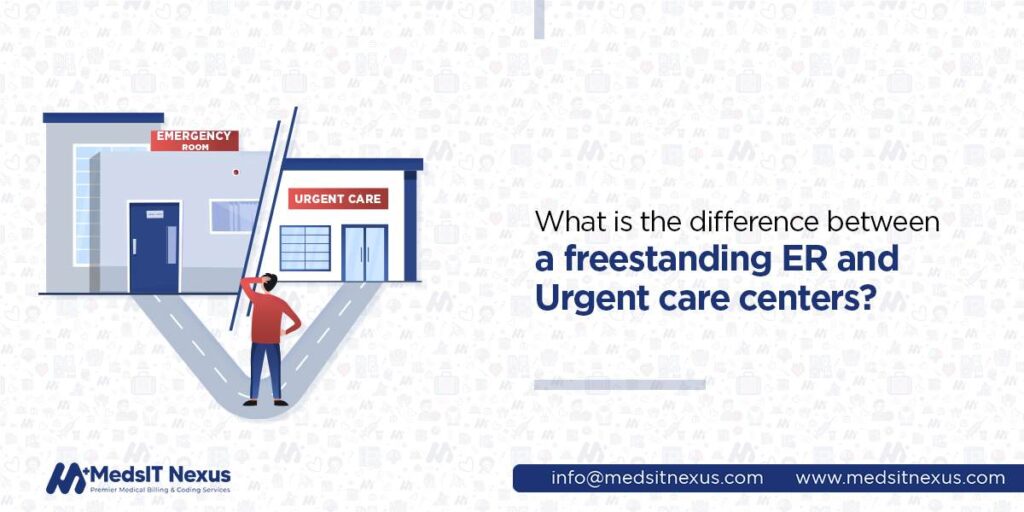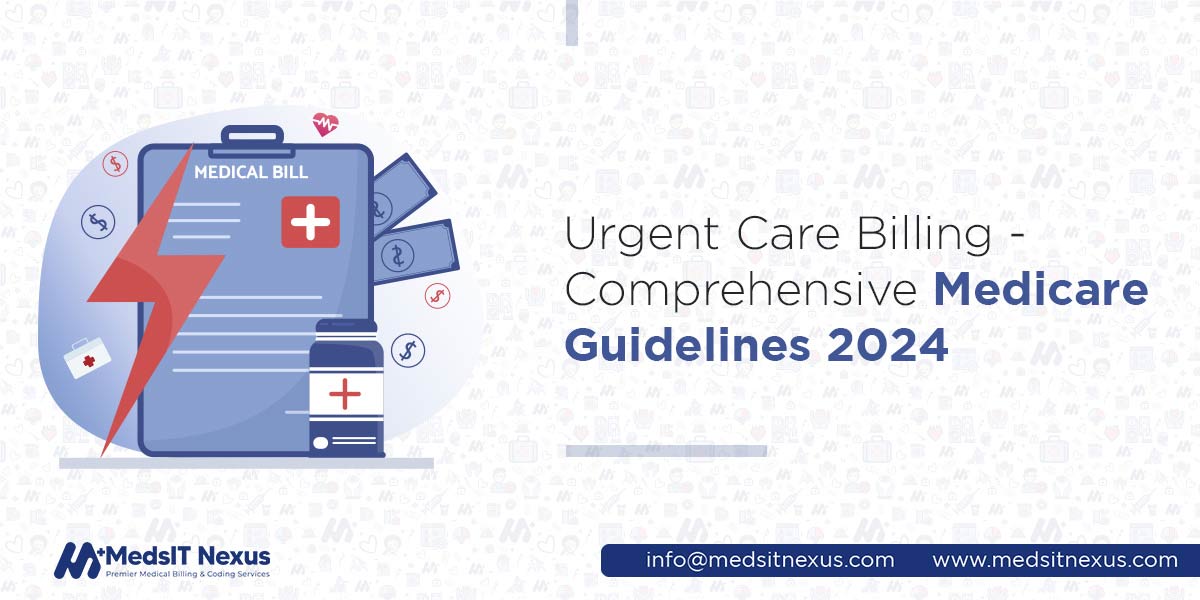Urgent care documentation

In healthcare provision, the meticulous documentation of patient interactions is the cornerstone for
healthcare providers. Achieving a seamless Revenue Cycle Management (RCM) commences with the precise
documentation of patient visits, encompassing every facet from the initial consultation to
post-operative care. Thoroughly recording patient data, medical history, and treatment specifics lays
the foundation for accurate coding, ensuring compliance with established guidelines, and optimizing
reimbursement. Proper documentation serves as a linchpin, not only enhancing patient care but also
facilitating audits, and compliance reviews and offering legal protection. It not only supports the
precise coding of services but also underscores the medical necessity of the care provided. Furthermore,
precise clinical documentation of Evaluation and Management (E/M) care and, subsequently, inpatient
acuity is paramount. These details are pivotal in determining quality metrics, serving as vital
indicators of overall hospital quality, especially in the context of CMS value-based payments and
rankings.
However, patient care is the utmost priority that demands particular focus and time; therefore, spending
proper time on documentation is a challenging task for healthcare providers. In this hustle to maintain
a balance between fulfilling accurate documentation requirements and rendering full-time patient care,
urgent care practitioners may make mistakes, leading to decreased reimbursement and penalties. To soothe
this concern, MedsIT Nexus is there to shake hands with you in performing your documentation
requirements flawlessly.
Urgent Care Documentation: Navigating Requirements & CMS Guidelines |Meeting 3 Critical Components for New and Established Patients
Two categories are there to document and code urgent care services.
New patients: Patients who have not received service in the last three years. Key
components must meet or exceed the documentation guidelines in all three areas to appropriately assign
the E/M code.
Established patients: Patients who have received medical services within the last three
years. Two of the three components must meet or exceed documentation requirements.
So, what are the three key components you should know to document services in urgent care properly?
Component # 1: History
The first component, history, is vital in comprehending the patient's condition thoroughly. It encompasses several elements, including:
Chief complaint:
A detailed description of the reason for the patient's visit sets the stage for further evaluation and diagnosis.
History of present illness:
History of the present illness describes the development of the patient's condition from the initial
sign and symptom to the current condition/state. A brief history necessitates documentation of 1-3
elements, while an extended history includes four or more.
Listed below is the detail of each factor that must be documented.
| Location | Place on the patient body where the patient is experiencing signs and symptoms |
| Quality | Adjective describing the nature of the chief complaint or symptoms, such as throbbing, dull, or sharp |
| Severity | Description/statement of the intensity or severity of the symptoms experienced by the patient. |
| Duration | Duration of time during which the patient has been experiencing the signs and symptoms, for instance, over the past two years. |
| Timing | Timing of when the symptoms occur, such as in the morning, during physical activity, or at night. |
| Context | Details about the patient's activity or location when the symptoms first appeared, such as climbing stairs or cutting fruit. |
| Modifying factors | Factors that alleviate or exacerbate the symptoms indicating what makes the condition better or worse. |
| Associated signs and symptoms | Other signs and symptoms the patient is experiencing |
Review of system (ROS):
For the review system, documenting one system is problem pertinent (99202, 99213), 2-9 system is
extended (99203, 99214), and the above ten systems is Complete (99215, 99204, 99205).
All 14 systems that can be reviewed and documented are listed below.
| Eyes | Integumentary |
|---|---|
| Constitutional | Musculoskeletal |
| Cardiovascular | Neurological |
| ENT | Immunologic |
| Respiratory | Lymphatic/hematological |
| Genitourinary | Endocrine |
| Gastrointestinal | Psychiatric |
Documentation tips-ROS
- The "all-inclusive" statement for ROS is being overused, especially in cases where it is not medically necessary. For example, it would not be required to document a comprehensive ROS for most established care visits.
- Keep in mind that the lower levels of service require only 2-9 systems.
- For a system review of 13 or less, each system must be listed individually to include at least 10 when necessary. Let’s consider how a ROS should be documented when listed separately.
| Eyes | No discharge |
| Constitutional | No fever |
| ENT | No sore throat, no nasal congestion, no dental pain, no hearing changes |
| Respiratory | No cough |
| CVS | No chest pain |
| MSK | No joint pain |
| Genitourinary | No dysuria |
| Neurologic | No headache, no speech problems |
- Review and document 14 systems when medically necessary.
- Be sure to use consistent notation, which allows the specific number of systems reviewed to be identified.
- All-inclusive statements could be created as macros or phrases in the HER. Here are a couple of examples of acceptable statements and a couple of examples of unacceptable statements.
| Acceptable |
| Statement # 1: “Pertinent positives and negatives as per HPI. All other systems have been reviewed and reported as negative." |
| Statement # 2: “Patient complains of chest pain and tingling in the right arm. He denies abdominal or back pain. Reviewed seven other systems; all findings are negative.” |
| Unacceptable statements |
|---|
| All systems reviewed are negative, except for those mentioned in the HPI. |
| Other systems reviewed are negative |
| ROS non-contributory |
| ROS is otherwise unremarkable. |
| Five systems were reviewed, and the remainder are negative. |
Past, Family, and Social History:
| Past medical history | A review of the patient’s past experiences with illnesses, injuries, and treatments. For instance: Prior illness, injuries, hospitalization, surgeries, age appropriateness, immunization status |
| Family history | A review of medical events in the patient’s family. For instance, Health status, cause of death, and specific diseases related to the chief complaint. |
| Social history | An age-appropriate review of past and current activities. For instance: Marital status, occupation, use of alcohol and drugs, lifestyle. |
Documentation considerations for PFSH
Past, family, and social history documentation require 1-3 elements for pertinent history, and for an
established patient, 2 of 3 elements must be met. However, a complete history for a new patient requires
3 of 3 to be included in the document.
The statements that must be avoided when documenting a patient’s family history are:
- Deceased at age (e.g., age 40) or age unknown
- Deceased
- Both parents deceased
- Alive
- Other
- Family history “not on file”
Component # 2: Physical exam
For physical exams, most levels of services require documentation of either body areas or organ systems.
| Body areas | Organ system |
|---|---|
| Head including face | Eyes |
| Neck | CVS |
| Chest including Axilla and breast | GI |
| Abdomen | Respiratory |
| Genitalia, groin, buttocks | ENT |
| Back | Skin |
| Each extremity | Neurologic |
| Psychiatric | |
| MSK | |
| Hematologic, lymphatic, immunologic |
- The comprehensive level of service (99204, 99205, 99215) requires eight or more organ systems only.
- A detailed level of service (99203, 99214) requires 2-7 body areas or organ systems.
- 2-4 boy areas or organ systems are required for expanded problem-focused services.
- One body area or organ system is required for problem-focused services.
Physical exam documentation tips & guidelines (Body areas vs. Organ system)
Differentiating between body areas and organ systems within HEENT is crucial.
- When HEENT is documented as "head is atraumatic," it refers to the body area only, specifically the head. However, if the documentation includes details such as "PERLA (pupil, equal, round, and reactive to light and accommodation)" and "pharynx is clear," it encompasses two organ systems: Eyes and ENT (ears, nose, and throat).
- In the context of documentation, the neck can be perceived as a body area. When described as "non-tender," it signifies a single body system, specifically the musculoskeletal (MSK) system. However, if the documentation includes additional details such as "no lesion (skin)," "good pulses (cardio)," "full range of motion (musc or neuro)," and "no lymphadenopathy (lymph)," it expands to cover four organ systems: Skin, Cardiovascular (heart and blood vessels), Musculoskeletal, and Lymphatic.
According to CMS guidelines, it is crucial to provide specific details when documenting abnormal or relevant negative findings during a patient's examination. Simply stating "abnormal" without further explanation is not enough. Similarly, phrases like "within normal limits" or "normal" are insufficient. The documentation should indicate what is abnormal and how it deviates from the norm. Additionally, if unexpected findings are discovered in body areas or organ systems unrelated to the patient's symptoms, these findings must be described in detail. For instance, if a patient presents with a headache and an examination reveals abnormal respiratory issues, merely stating "abnormal" is inadequate. The documentation should specify the nature of the abnormality and provide a comprehensive description of the findings.
Component # 3: Medical decision making: New vs. Established patients
Keeping a close eye on the decision-making level is necessary while documenting urgent care services.
There are four levels of medical decision-making in urgent care: Straightforward complexity (99201,
99202, 99212), Low complexity (99203, 99213), Moderate complexity (99204, 99214), and High complexity
(99205, 99215)
Here are the levels of service and the number of components from each area that need to be documented to
meet the expected level for a new patient.
| Level of service | MDM | History | Exam |
| 99201 | Straightforward |
|
One body area or organ system |
| 99202 | Straightforward |
|
2-4 body areas or organ systems |
| 99203 | Low |
|
5-7 body areas or organ systems |
| 99204 | Moderate |
|
Eight or more organ systems only |
| 99205 | High |
|
Eight or more organ systems only |
Here are the levels of service and the number of components from each area that need to be documented to meet the expected level for an established patient.
| Level | MDM | HPI | Exam |
| 99211 | N/A |
Chief complaint ROS: N/A HPI: N/A Past, family & social history: N/A |
N/A |
| 99212 | Straightforward |
Chief complaint ROS: N/A HPI: 1-3 elements PFSH: N/A |
One body area or organ system |
| 99213 | Low |
Chief complaint ROS: 1 system HPI: 1-3 elements PFSH: N/A |
2-4 body areas or organ systems |
| 99214 | Moderate |
Chief complaint ROS: 2-9 systems HPI: 4+ elements PFSH: 1 of 3 areas |
5-7 body areas or organ systems |
| 99215 | High |
Chief complaint ROS: 10+ systems HPI: 4+ elements PFSH: 2 of 3 areas |
Eight or more organ systems only |
Describing the nature of the presenting problem is crucial as it is the primary factor in determining
the level of service. For instance, if the presenting problem is of high or comprehensive severity, even
if the healthcare practitioner's documentation suggests a lower complexity level, the encounter will
still be classified and coded as a high complexity level.
Besides these three critical components, other common but crucial documentation required
Patient Information: One of the fundamental aspects of urgent care documentation is the
collection and recording of patient information. This includes demographic details, contact information,
medical history, and insurance details.
Diagnostic Tests and Procedures: Documenting the results of diagnostic tests, such as
laboratory tests, X-rays, or electrocardiograms, is vital for tracking the patient's progress and
ensuring timely interventions. Providers must accurately record the tests performed, their results, and
the interpretation of these results, providing a basis for treatment decisions.
Diagnosis and Treatment Plan: A precise diagnosis and a well-defined treatment plan are
the cornerstones of urgent care documentation. Providers must clearly state the diagnosis, supported by
the patient's symptoms, physical examination findings, and test results. The treatment plan should
include prescribed medications, procedures performed, follow-up instructions, and referrals, if
necessary. Documenting the rationale behind the chosen treatment options adds clarity to the medical
record.
Informed Consent: Informed consent is a legal and ethical requirement in healthcare.
Providers must document the process of obtaining the patient's informed consent for treatments,
procedures, or surgeries. The documentation should include a description of the treatment, potential
risks and benefits, alternatives, and the patient's agreement to proceed. Informed consent forms should
be signed and dated by the patient or their legal guardian.
Time: In cases where time plays a crucial role during the patient encounter, it is
imperative to document the duration of time spent with the patient accurately.
Best urgent care documentation services with MedsIT Nexus: A comprehensive billing platform
MedsIT Nexus is a premier provider of urgent care documentation services, offering unparalleled expertise and a comprehensive billing platform that ensures seamless operations for healthcare facilities. With years of experience in the field, MedsIT Nexus boasts a team of certified coders with a deep knowledge of the specifications of urgent care documentation, coding, and billing. The platform strictly adheres to the guidelines set forth by the Health Insurance Portability and Accountability Act (HIPAA), ensuring the confidentiality and security of PHI. What sets MedsIT Nexus apart is its exceptional ability to capture accurate documentation, allowing healthcare providers to focus on delivering high-quality patient care. The professionalism exhibited by our team is evident in their attention to detail and commitment to providing top-notch services. Moreover, MedsIT Nexus prides itself on offering round-the-clock support, providing healthcare facilities with the assurance of continuous assistance whenever needed. Contact us today, and let us help you take your urgent care facility to the heights of success.
Marshall-Russ, Technical Author -
Healthcare IT & Data Systems Analyst at MedsIT Nexus
Edit Technical documentation, workflow automation insights, and data-driven RCM improvement publications following our standard publication protocols.






